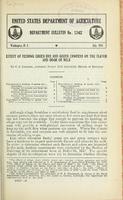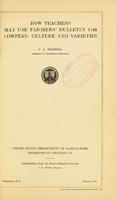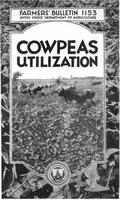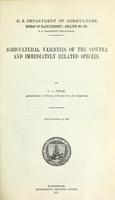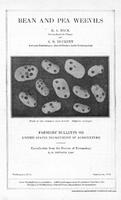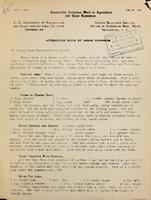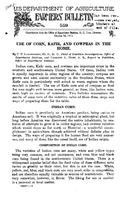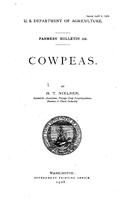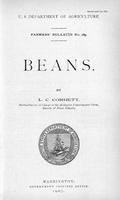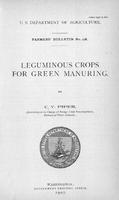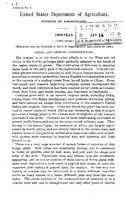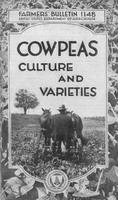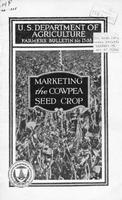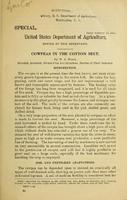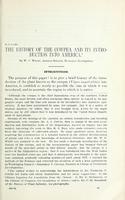Browse Items: 18
Page 1 of 1
Legume Hays for Milk Production
AN ABUNDANCE of home-grown legume hay establishes a basis for an economical dairy ration.
Legumes are superior to other hays in palatability, in quantity and quality of the proteins furnished, and in content of lime. As a class they yield more nutrients per acre than do nonlegumes, and protein is obtained at a lower cost.
In spite of these…
Legumes are superior to other hays in palatability, in quantity and quality of the proteins furnished, and in content of lime. As a class they yield more nutrients per acre than do nonlegumes, and protein is obtained at a lower cost.
In spite of these…
Effect of Feeding Green Rye and Green Cowpeas on the Flavor and Odor of Milk
When dairy cows consumed 15 pounds of green rye one hour before milking only slight abnormal flavors and odors were produced in the milk.
Increasing the amount of green rye consumed one hour before milking from 15 to 30 pounds increased to a slight extent the abnormal flavors and odors in the milk. They were, however, only slight and would…
Increasing the amount of green rye consumed one hour before milking from 15 to 30 pounds increased to a slight extent the abnormal flavors and odors in the milk. They were, however, only slight and would…
How Teachers May Use Farmers' Bulletin 1148: Cowpeas: Culture and Varieties
THE TEACHING OF AGRICULTURE in any community should have a vital connection with the problems of the farms of that community. Pupils are interested in those things about which they have some knowledge. The type of agriculture practiced in the community can be used to the best advantage in teaching. Therefore the teacher should organize the…
Cowpeas: Utilization
THE COWPEA PLANT may be fed to live stock as pasturage, hay, or ensilage, and the seed may be used as human food. Cowpeas are not grown for seed more generally because of the uncertainty of the crop, the expense of harvesting, and the low yield commonly obtained. These factors have created a relatively high price for the seed.
In localities well…
In localities well…
Agricultural Varieties of the Cowpea and Immediately Related Species
The cowpea is now the most important legume grown in the cotton States. At the present time about 15 varieties of this crop are in common cultivation in these States. The varieties grown in a small way number perhaps twice as many more. Owing to the fact that the seed is still largely hand picked, the tendency is for whatever variety was first…
Beans, Peas, and Other Legumes as Food
The cowpea belongs to the bean family; but it is the "field pea" of the Southern States. There are several varieties—the "red" and "black" varieties, the round "lady" peas, the large "black-eye" and "purple-eye," and the variously mottled and speckled "whippoorwill" peas, besides many others. There are both trailing and bush varieties. The plant…
Bean and Pea Weevils
BEANS, PEAS, AND COWPEAS are often damaged seriously in storage and in the field by weevils. Velvet beans and soy beans are rarely infested in this country. Bean and pea weevils not only destroy much of the Nation's food in the form of leguminous crops hut are responsible for a curtailment in the acreage planted to these crops. They never attack…
Attractive Ways of Using Cowpeas
Since there is a large surplus of cowpeas just at this season we need to stress attractive ways of using them. They are a nourishing food and make good meat substitute dishes. The cowpeas for the loaf, croquettes and for salads are better if cooked in a fireless cooker from 4 to 5 hours.
Use of Corn, Kafir, and Cowpeas in the Home
The cowpea is a member of a large botanical family known as the Leguminosse, whose fruit or seeded pods are called legumes. It is said to be native to Africa and early in the eighteenth century was introduced into the United States by way of the West Indies. Gradually it spread northward and late in the century we have record of its cultivation as…
Cowpeas
A system of agriculture without the use of a leguminous crop tends to lessen the productivity of the soil and makes necessary large outlays for nitrogenous fertilizers. With a leguminous crop grown at frequent intervals, the productivity may be maintained or even increased. The cowpea (fig. 1) is at the present time, and probably will continue to…
Beans
The cowpea (Vigna sinensis), because of its bean-like seed and habit of growth, its great economic importance as a forage crop for the production of hay and silage, and its great value as a green manure, should be mentioned in connection with the other plants to which it is so closely related both botanically and economically.
Leguminous Crops for Green Manuring
The cowpea (fig. 5) is used more than any other crop as a soil renovator in the South. Its use is rapidly increasing, but is yet far from general. During the past few years the high price of the seed has tended to discourage more extensive growing. Recent progress in the harvesting of cowpea seed by machinery will doubtless materially reduce its…
Cowpeas
The chief functions of this crop, then, are to furnish large amounts of nitrogen abstracted from the air and fixed in the roots and stubble in a conveniently available form for the use of succeeding crops; second, to produce a large yield of vines and peas rich in digestible protein, which, either as hay or for soiling purposes, will take the place…
Cowpeas: (Vigna catjang)
The cowpea is to the South what alfalfa is to the West and red clover to the North — a forage plant perfectly adapted to the needs of the region where it grows. The cultivation of this crop in America dates back to the early part of the eighteenth century. A South Carolina planter received a quantity of seed from a foreign source, which, according…
Cowpeas: Culture and Varieties
THE COWPEA is the best known and most extensively grown leguminous crop in the Southern States. It is grown mainly for forage and to improve the soil, but the seeds are rather commonly used for human food.
The cowpea is of the greatest value in the cotton belt, although it can be grown profitably much farther north.
The cowpea will do best on…
The cowpea is of the greatest value in the cotton belt, although it can be grown profitably much farther north.
The cowpea will do best on…
Marketing the Cowpea Seed Crop
The annual farm value of cowpeas produced in the United States during recent years averages over $18,000,000. On most farms, however, the cowpea is grown largely as a catch crop, is considered of secondary importance as a money crop, and in many instances is handled in an unbusinesslike manner. This results not only in a direct monetary loss to the…
Cowpeas in the Cotton Belt
The cowpea is at the present time the best known and most extensively grown leguminous crop in the cotton belt. Its value for hay, grazing, catch and cover crops, and for soil improvement is well known and thoroughly appreciated by farmers. The feeding value of the forage has long been recognized, and it is used for all kinds of live stock. Cowpea…
The History of the Cowpea and its Introduction Into America
The purpose of this paper is to give a brief history of the introduction of the plant known as the cowpea (Vigna unguiculata) into America, to establish as nearly as possible the time at which it was introduced, and to ascertain the region to which it is native.
Although the cowpea is the chief leguminous crop of the southern United States, the…
Although the cowpea is the chief leguminous crop of the southern United States, the…
Page 1 of 1
 An official website of the United States government.
An official website of the United States government.



